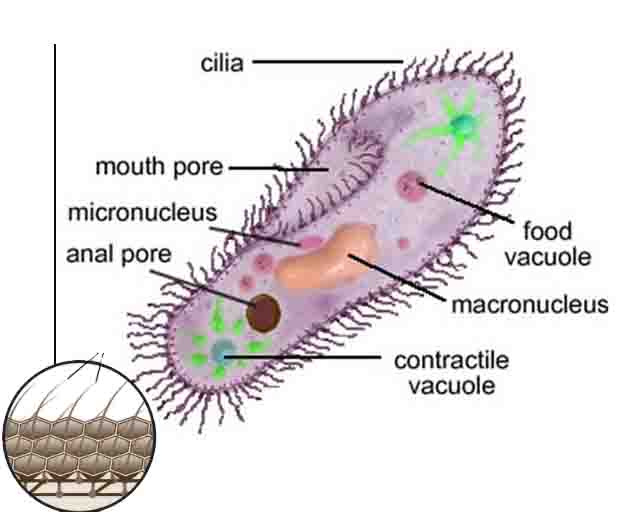Cilium Definition
A cilium, or cilia (plural), are small hair-like protuberances on the outside of eukaryotic cells. They are primarily responsible for locomotion, either of the cell itself or of fluids on the cell surface. They are also involved in mechanoreception.
There is even a class of microorganisms named for these small structures. Ciliates are protozoans that possess cilia which they use for both locomotion and feeding.
Structure of Cilium
A cilium is made up of microtubules coated in plasma membrane. The microtubules are small hollow rods made of the protein tubulin. Each cilium contains nine pairs of microtubules forming the outside of a ring, and two central microtubules.
This structure is known as an axoneme, and the arrangement as ‘9+2’, an arrangement ubiquitous in motile cilia. The microtubules are held together by cross-linking proteins. Between the nine outer pairs are motor proteins called dynein.
Cilia attach to the cell at a basal body. The basal body is made up of microtubules arranged as nine triplets. The triplets are formed as the doublets from the cilia are joined by an additional microtubule from the cell. The two central microtubules end before entering the basal body.
The motor proteins (dynein) are large flexible molecules that allow the cilia to be motile. The proteins hydrolyze ATP for energy. As the proteins are activated, they undergo conformational changes which allow for complex movements.
The dynein molecules essentially crawl along the microtubules, pulling the neighboring doublet up and reattaching further down. As the doublets are attached to each other through the cross-linking proteins they can only slide a short distance along each other. This movement causes bending in the cilium.
Cilia are very small structures – measuring approximately 0.25 μm in diameter and up to 20 μm in length. Where present they are found in large numbers on the cell surface. The cilia act like oars, beating back and forth to create movement.
Cilium Function
Cilia play an important role in locomotion. This can include movement of the cell itself, or of other substances and objects past the cell. In some organisms known as ciliates, cilia are responsible for movement of the organism as a whole.
For example, in the unicellular protist Paramecium, cilia cover the surface of the organism and are responsible for movement as well as feeding. In addition to covering the outside of the organism, cilia also line the oral groove, moving food into the organism’s “mouth”.
Cilia can help to remove contaminants from organs or tissue by helping to move fluids over the cell. The lining of the nasopharynx and the trachea are covered in cilia. These ciliated epithelial cells remove mucus, bacteria, and other debris from the lungs.
Another example is the lining of the fallopian tubes. The cilia here are responsible for helping in fertilization by movement of the egg towards the uterus.
Kinocilia are a specialized type of cilia found on the apical ends of vertebrate hair cells. Along with stereocilia, non-motile collections of actin filaments related to cilia, they are involved in hearing and balance (mechanoreception).

